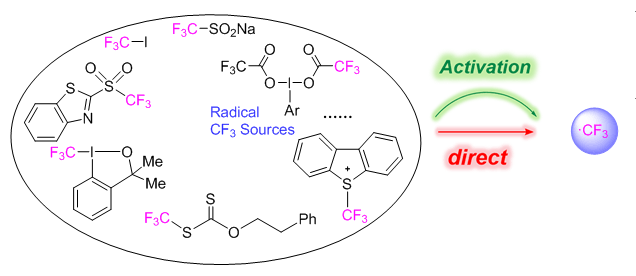摘要/Abstract

三氟甲基自由基源(·CF3)是发展自由基三氟甲基化反应的基础.采用密度泛函理论(M06-2X),系统研究35个常见三氟甲基源释放CF3自由基的能力(TR·DA:trifluoromethyl radical donor ability)及可能的途径.计算结果表明,35个三氟甲基源通过化学键均裂释放三氟甲基自由基所需能量跨度为-21.5至95.2 kcal·mol-1.单电子转移、卤键和硫键给体(halogen/chalcogen-bond donor)可促进CF3自由基释放.相关研究结果将有助于理解和设计新自由基三氟甲基化试剂和反应.
关键词: 自由基三氟甲基化试剂, 键均裂解离焓, 结构-活性关系, 卤键, 密度泛函计算
Organic compounds containing trifluoromethyl (CF3) group(s) are widely prevalent in biochemical and medicinal science. This is mainly due to the fact that the trifluoromethyl group often improves the metabolic stability and lipophilicity of biologically active compounds. The need of efficient methods for the incorporation of this group into target molecules has spurred research to discover new, practical CF3 sources. Among various CF3 sources, the radical trifluoromethylating reagents has provided a strong driving force for the discovery of the novel trifluoromethylation reactions, and contributed enormously to the efficient synthesis of various CF3-containing compounds. Although a wide variety of radical CF3 sources are now available to organic chemists, little attention has been paid to assess their trifluoromethyl radical donor abilities (TR·DA). Moreover, the available radical reagents show a very rich and diverse reactivity. The establishment of an extensive scale to quantify their CF3 radical donating abilities should be of great value for both the rational design of novel reagents and the judicious selection of appropriate reagent to explore new radical reactions. Herein, we present a systematic computational study of the homolytic X―CF3 bond dissociation enthalpies of 35 radical trifluoromethylating reagents by using the SMD-M06-2X/[6-311++G(2df, 2p)-Def2-QZVPPD]//SMD-M06-2X/[6-31+G(d)-LANL2DZ] method, aiming to provide an energetic guide for estimating their trifluoromethyl radical donor abilities. A comprehensive TR·DA scale was constructed, which covers a range from -21.5 to 95.2 kcal·mol-1. The effects of the frequently used activators including single electron transfer reagents and halogen/chalcogen-bond donors on trifluoromethyl radical donor abilities were investigated. The results show that single electron transfer is the most efficient way to promote the CF3 radical release. We expect that the results of this study could be highly valuable for the mechanistic understanding and the rational design of novel CF3 sources and new radical trifluoromethylation reactions.
Key words: radical trifluoromethylating reagent, homolytic bond dissociation enthalpy, structure-reactivity relationship, halogen bond, DFT calculation
PDF全文下载地址:
点我下载PDF
